Sensory Processing Disorder (SPD) is a condition in which a person’s brain cannot process sensory signals properly. It has not been recognized as an independent disease and is still not explicitly included in many diagnostic manuals. It means that the sensory signals that the body receives are not organized properly, which leads to lack of proper motor or behavioral response. This condition is called sensory integration dysfunction.
Everyone receives sensory signals at every moment -such as hearing sounds, touching things, seeing, tasting, and smelling. Our central nervous system responds immediately by using these signals correctly. But when SPD occurs, these signals get confused and the sensory information may become too overwhelming for the individual or cannot be processed in an optimal way.
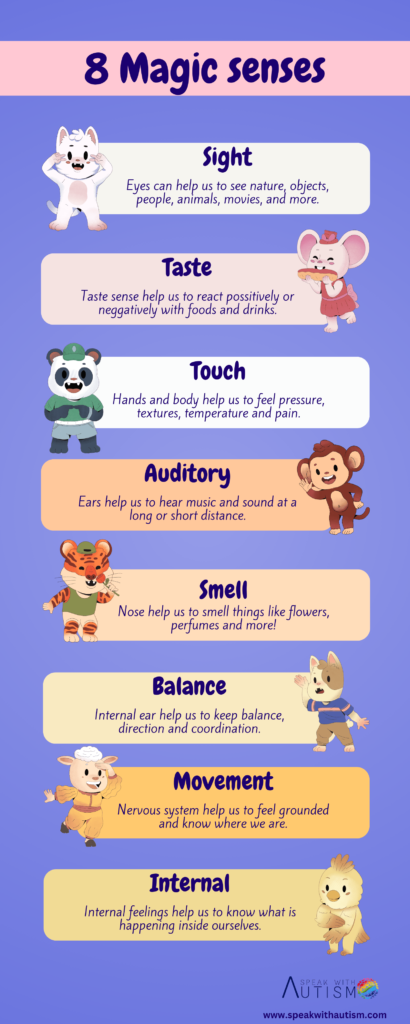
Table of Contents
SPD is not limited to a single sensory sense but can affect more than one sense. Each individual has a different response to it. Some people feel excessive sensory stimulation (over-responsive) while others do not feel sensory input at all (under-responsive).
SPD is often associated with Autism Spectrum Disorder (ASD), but it can be separate from it. Some psychological conditions such as PTSD (Post-traumatic stress disorder), ADHD (Attention deficit hyperactivity disorder), schizophrenia, borderline personality disorder, and various phobias may also be associated with SPD. This is why it takes a specialist to understand the condition well and make the correct diagnosis.
Main types of SPD
Sensory Processing Disorder is divided into four main types:
1. Sensory Modulation Disorder (SMD)
This disorder affects a person’s response to sensory input.
✅ Symptoms:
- When over-responsive, it is difficult to tolerate noise, light, or touch.
- When under-responsive, there is a need for sensory input, such as frequent blinking, staying in loud noises, or liking bright light.
- Some people show sensory cravings, requiring more movement and touch.
2. Sensory Discrimination Disorder (SDD)
In this type of SPD, the person has the inability to correctly differentiate or understand sensory information.
✅ Symptoms:
- Not being able to correctly judge force and pressure (such as breaking a pencil without knowing how much force to apply).
- Difficulty distinguishing between backdrop and foreground (such as not being able to see a small shadow on a heavy body).
- Difficulty recognizing the shape, size, or texture of objects.
- Loss of balance while walking or doing tasks with hands.
3. Sensory-Based Motor Disorder (SBMD)
In this type of SPD, the person is unable to control his/her body movements properly.
✅ Symptoms:
- Problems in coordination and balance.
- Difficulties in activities such as writing, cutting, and dressing.
- Loss of movement planning (praxis), in which it is difficult to follow a task step-by-step.
- Difficulty tracking things with eyes.
4. Executive Dysfunction Symptoms of Sensory Processing Disorder
In this type, the person feels difficulty in planning, scheduling and following daily activities.
✅ Symptoms:
- Difficulty shifting from one task to another.
- Difficulty in fine motor coordination.
- Problem in following routine.
- Difficulty in personal organization and decision-making.
Reasons for SPD
The exact reasons for SPD are not yet clear, but several factors contribute to it:
- Genetic Link: It can be genetic, in which someone else in the family can also have similar symptoms.
- Neurological Development: People with SPD show differences in brain regions related to sensory processing.
- Environmental Factors: Any type of exposure during pregnancy, premature birth, or birth trauma can be the cause.
Treatment and Management of SPD
Although there is no specific treatment for SPD, it can be managed through sensory integration and therapy.
1. Occupational Therapy (OT)
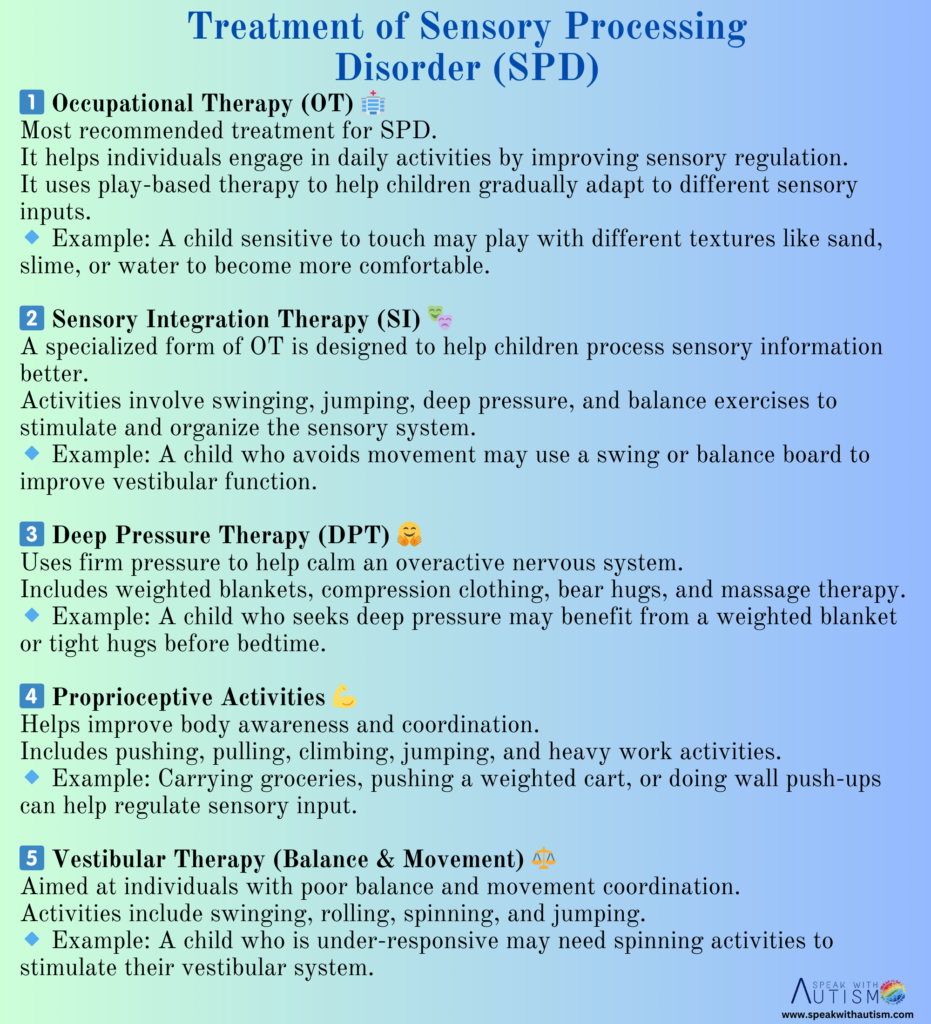
Occupational therapists use sensory integration therapy to train the individual to respond better to sensory input.
✅ Benefits:
- Helps in improving daily activities.
- Finding strategies to avoid sensory overloading.
- Improving motor coordination and balance.
2. Speech & Language Therapy
This therapy is beneficial for people who have trouble speaking or understanding things due to sensory processing.
3. SCERTS Model
This is a research-based educational model used for people on the Autism Spectrum and SPD.
4. DIR/Floor time Therapy
Developmental, Individual-Difference, Relationship-Based Model (DIR) is a therapeutic approach that focuses on children’s individual sensory needs.
5. Sensory Diet
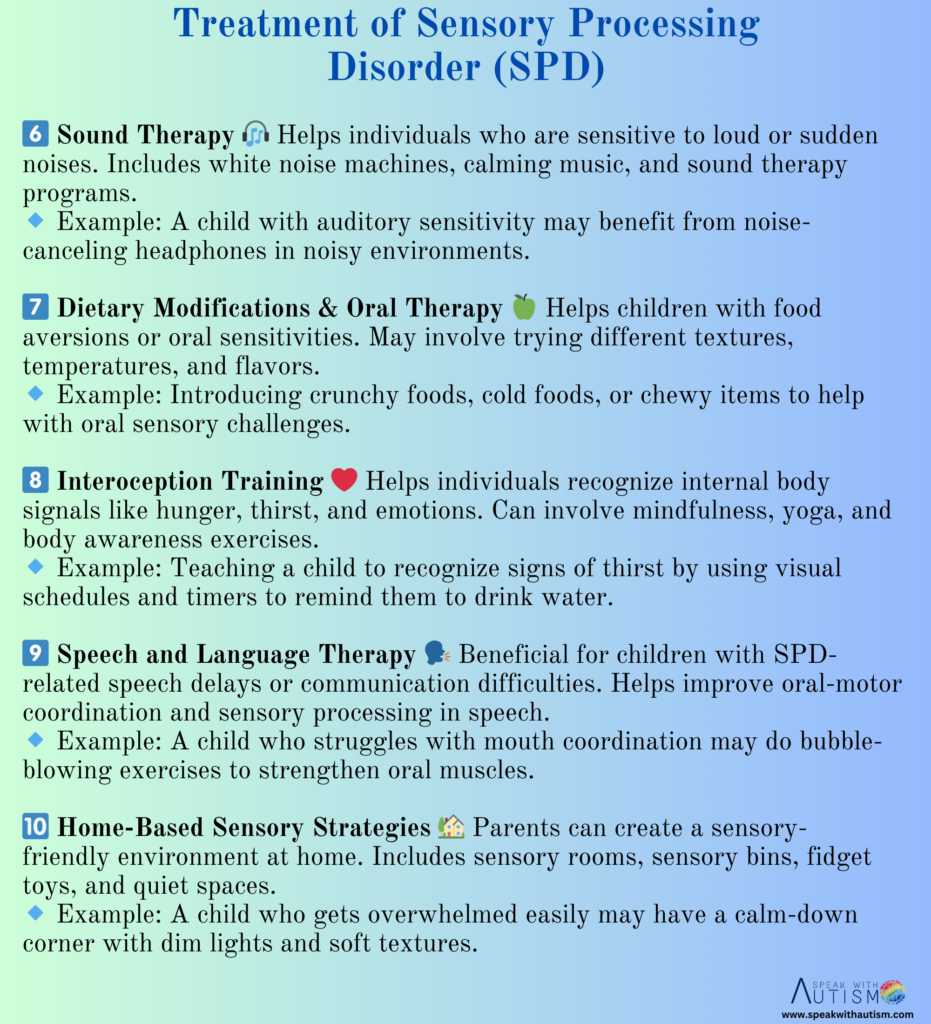
A therapist can design a sensory diet, which plans daily activities and exercises based on sensory needs.
Ways to Live Better with SPD
If a person has SPD, some strategies can help improve their life:
- Sensory-Friendly Environment: Create environments with low-light, soft textures, and limited noise to avoid overstimulation.
- Calming Techniques: Adopt techniques such as deep pressure therapy, weighted blankets, and yoga.
- Routine and Structure: Create a structured and predictable routine that reduces anxiety.
- Proper Support: Take proper guidance from therapist, parents and teachers.
8 Sensory Systems and their Symptoms
1. Tactile (Touch) Sensory System
The sense of touch helps us understand different sensations by feeling objects. Babies often explore texture and temperature by sucking on things.
✅ Hypersensitive Symptoms (Over-Responsive)
- Feels discomfort from clothing tags or specific textures
- Experiences mild pain or discomfort from light touch
- Finds haircuts or nail trimming uncomfortable
- Has an urgent need to clean hands or feet if they get dirty
✅ Hyposensitive Symptoms (Under-Responsive)
- Feels little to no pain even after falling or getting hurt, shows no reaction
- Has a habit of sucking or touching everything without thinking
- Enjoys playing in sand, mud, or water excessively
- Is indifferent to clothing textures or sensations
2. Vestibular (Balance & Movement) Sensory System
This system helps maintain balance and movement control.
✅ Hypersensitive Symptoms (Over-Responsive)
- Afraid of swinging, walking fast, or spinning
- Feels dizzy when tilting or turning the head upside down
- Avoids jumping and running
- Has difficulty walking and often falls
✅ Hyposensitive Symptoms (Under-Responsive)
- Seeks excessive swinging, spinning, and high-speed movements
- Struggles to maintain balance
- Constantly shakes or sways
- Frequently falls without any apparent reason
3. Proprioceptive (Body Awareness) Sensory System
This system helps us understand the position of our body parts without looking at them.
✅ Hypersensitive Symptoms (Over-Responsive)
- Walks very slowly, hesitates to apply force
- Exerts too much effort when lifting objects or performing activities
- Holds objects either too tightly or too loosely
✅ Hyposensitive Symptoms (Under-Responsive)
- Seeks deep pressure, such as tight hugs or squeezing activities
- Holds a pencil too tightly while writing
- Engages excessively in pushing, pulling, and jumping activities
- May struggle with social interactions and sometimes gets into conflicts without an apparent reason.
4. Auditory (Hearing) Sensory System
This system processes sounds and helps us interpret auditory information.
✅ Hypersensitive Symptoms (Over-Responsive)
- Feels terrified by loud noises (such as sirens, firecrackers, or microphones)
- Covers ears in response to loud sounds
- Finds even normal sounds overwhelming or irritating
- Struggles to process multiple sounds at once
✅ Hyposensitive Symptoms (Under-Responsive)
- Ignores loud noises or does not react to them
- Listens to the same sound or song repeatedly
- Repeats their own voice or other sounds frequently
- Does not respond when called by name or given instructions
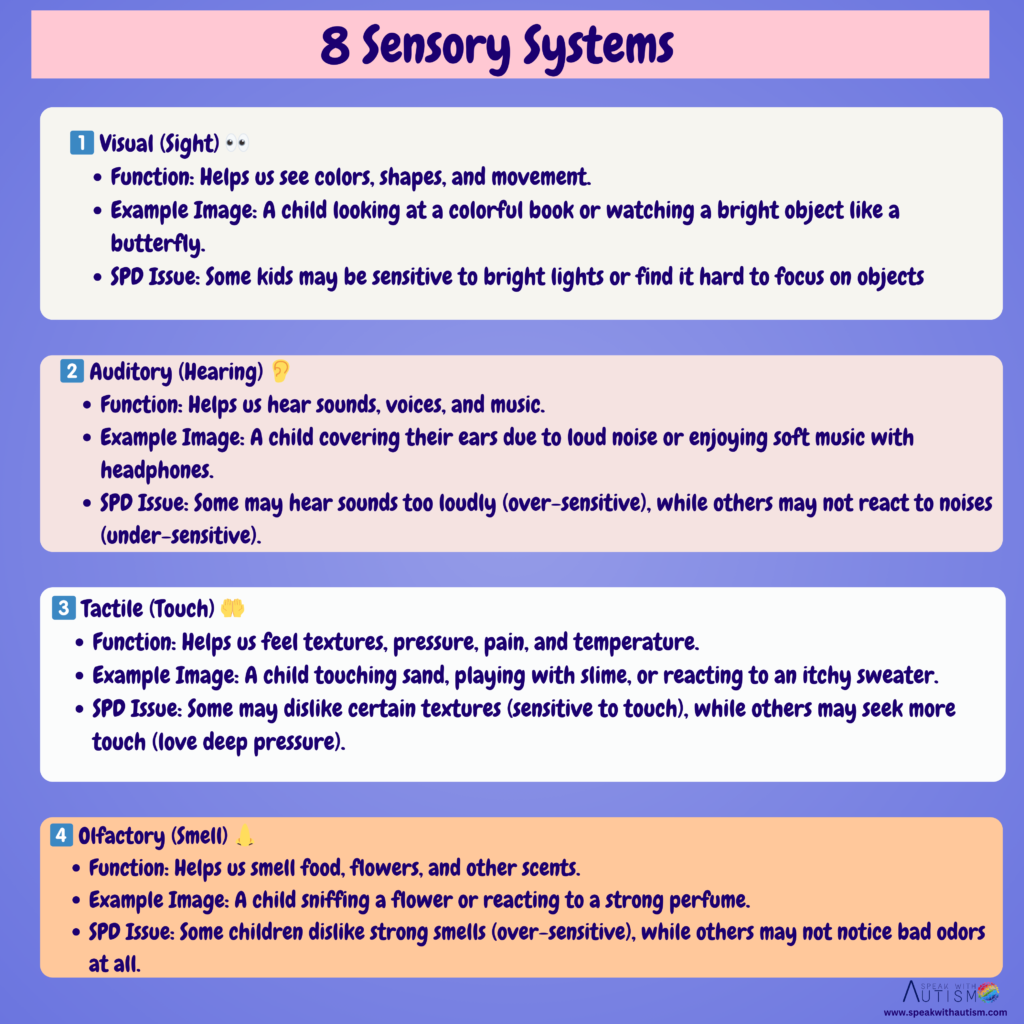
5. Visual (Sight) Sensory System
This system processes the information seen through the eyes.
✅ Hypersensitive Symptoms (Over-Responsive)
- Bright or fluorescent light causes irritation.
- Too many patterns, colours or visual clutter is annoying.
- Closes eyes in bright or shiny places.
- Has difficulty in talking while maintaining eye contact.
✅ Hyposensitive Symptoms (Under-Responsive)
- Has a habit of looking at things from very close.
- Likes to look at fast moving things (such as spinning wheels or things).
- Is more attracted towards light or shiny things.
- Likes to look at the same thing repeatedly.
6. Gustatory (Taste) Sensory System
This system controls taste and food-related feelings.
✅Hypersensitive Symptoms (Over-Responsive)
- Do not eat food with a particular taste or texture (like only crunchy or soft food).
- Does not like spicy or tasteless food.
- Refuses to try new food.
- Always wants to eat the same type of food.
✅ Hyposensitive Symptoms (Under-Responsive)
- Likes very spicy, tangy or spicy food.
- Has a habit of chewing or keeping things in the mouth repeatedly.
- Tries to taste things repeatedly with the tongue.
- Sometimes he puts non-food items (like pencil, clay, paper) in his mouth.
7. Olfactory (Smell) Sensory System
This system enables us to smell and smell the fragrance of things.
✅ Hypersensitive Symptoms (Over-Responsive)
- Even normal smells seem very strong.
- Complains of smell coming from everywhere.
- The smell of some special perfume, food or chemical seems very strong.
✅ Hyposensitive Symptoms (Under-Responsive)
- Even very strong smells are not felt.
- Has the habit of smelling everything.
- Has a liking for smelling strange things (like soil, cloth, paper).
8. Interoception (Internal Body Signals) Sensory System
This system helps in feeling internal signals of the human body such as hunger, thirst, heat, cold, pain, and going to the bathroom (not toilet trained easily).
✅ Hypersensitive Symptoms (Over-Responsive)
- Even slight pain or small things hurt more.
- Feels hungry or thirsty repeatedly.
- Feels stomach ache or physical discomfort.
✅ Hyposensitive Symptoms (Under-Responsive)
- Does not pay attention to hunger or thirst.
- Ignores going to the bathroom or physical discomfort.
- Does not feel or react even when there is pain.
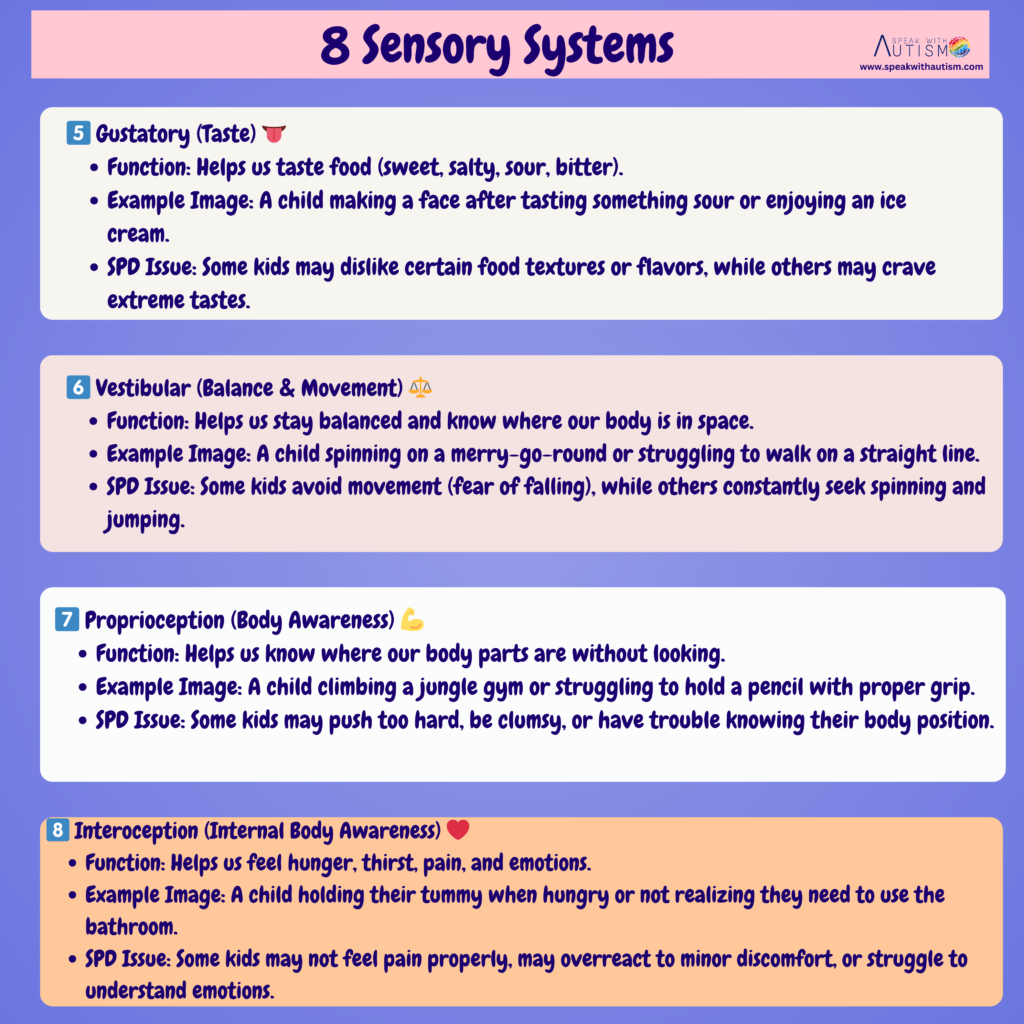
Conclusion
Sensory Processing Disorder is a cognizable and understandable condition that affects a person’s daily life. Although it is not included in the DSM (Diagnostic and Statistical Manual of Mental Disorders) as a separate disease, its symptoms have been seen with autism, ADHD, and other developmental disorders.
The most important thing is that if you or someone you know has symptoms of SPD, seek advice from an experienced therapist or specialist. It is possible to manage sensory challenges with proper intervention and therapy.
Frequently Asked Questions (FAQ’s)
What causes sensory processing disorder?
The exact reasons for SPD are not yet clear, but several factors contribute to it:
Genetic Link: It can be genetic, in which someone else in the family can also have similar symptoms.
Neurological Development: People with SPD show differences in brain regions related to sensory processing.
Environmental Factors: Any type of exposure during pregnancy, premature birth, or birth trauma can be the cause.
How to help a child with sensory processing disorder?
If a person has SPD, some strategies can help improve their life:
Sensory-Friendly Environment: Create environments with low-light, soft textures, and limited noise to avoid overstimulation.
Calming Techniques: Adopt techniques such as deep pressure therapy, weighted blankets, and yoga.
Routine and Structure: Create a structured and predictable routine that reduces anxiety.
Proper Support: Take proper guidance from therapist, parents and teachers.
What is Sensory Processing Disorder (SPD)?
Sensory Processing Disorder (SPD) is a condition in which the brain cannot process sensory information (such as seeing, hearing, eating, smelling, movement, balance and body awareness) properly. SPD can cause a person to either feel sensory input too much (hypersensitivity) or not feel it as much as normal (hyposensitivity).
Its symptoms start appearing from childhood itself and if it is not treated timely then it can affect the daily activities of children like school, sports and social interaction. SPD can affect different sensory systems, which include 8 main sensory systems.
